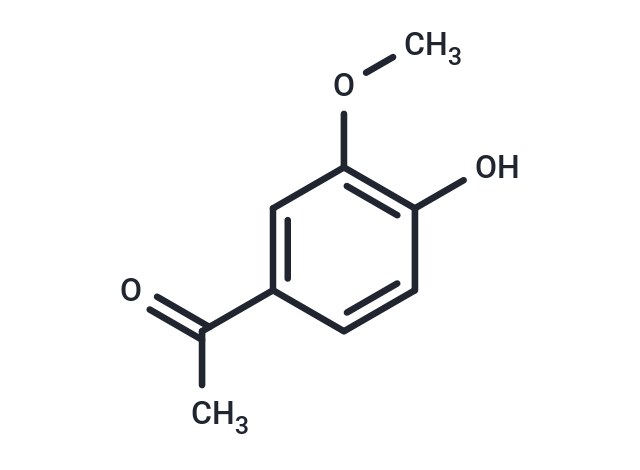Shopping Cart
- Remove All
 Your shopping cart is currently empty
Your shopping cart is currently empty

Apocynin (NSC 2146) is a specific NADPH-oxidase inhibitor (IC50: 10 μM).

| Pack Size | Price | Availability | Quantity |
|---|---|---|---|
| 1 g | $50 | In Stock | |
| 1 mL x 10 mM (in DMSO) | $50 | In Stock |
| Description | Apocynin (NSC 2146) is a specific NADPH-oxidase inhibitor (IC50: 10 μM). |
| Targets&IC50 | NADPH oxidase:10 μM |
| In vitro | Apocynin demonstrates anti-inflammatory activity by reducing neutrophil infiltration, the extent of spinal cord injury, the formation of PAR and nitrotyrosine, and the expression of ICAM-1 and P-selectin. It inhibits the degradation of IκB-α, activation of NF-κB, and apoptosis (as indicated by TUNEL staining, FAS ligand, Bax, and Bcl-2 expression), and the production of pro-inflammatory cytokines (TNF-α and IL-1β) and the activation of MAPK pathways (P-38 and phosphorylated-JNK). The LD50 in mice is 9 g/kg (p.o.). Apocynin is effective in various inflammatory cells and animal models. It attenuates the production of TNF-α and IL-1β, and the expression of iNOS in the lungs of mice treated with carrageenan. Moreover, apocynin offers beneficial effects in mouse models of spinal cord injury. |
| In vivo | Upon metabolic transformation, Apocynin can inhibit the assembly of NADPH oxidase, possibly due to the production of reactive oxygen species (ROS). It achieves this by inhibiting the serine phosphorylation of p47phox and disrupting its interaction with gp91phox, thereby inactivating NADPH oxidase activity. Furthermore, Apocynin reduces the generation of superoxide (O(2)(-)) in activated macrophages and neutrophils. |
| Alias | NSC 2146, Acetovanillone, Acetoguaiacone |
| Molecular Weight | 166.17 |
| Formula | C9H10O3 |
| Cas No. | 498-02-2 |
| Smiles | COC1=C(O)C=CC(=C1)C(C)=O |
| Relative Density. | 1.158 g/cm3 |
| Storage | Powder: -20°C for 3 years | In solvent: -80°C for 1 year | Shipping with blue ice. | ||||||||||||||||||||||||||||||||||||||||
| Solubility Information | DMSO: 45 mg/mL (270.81 mM), Sonication is recommended. Ethanol: 16.6 mg/mL (99.9 mM), Sonication is recommended. | ||||||||||||||||||||||||||||||||||||||||
Solution Preparation Table | |||||||||||||||||||||||||||||||||||||||||
Ethanol/DMSO
DMSO
| |||||||||||||||||||||||||||||||||||||||||

Copyright © 2015-2025 TargetMol Chemicals Inc. All Rights Reserved.